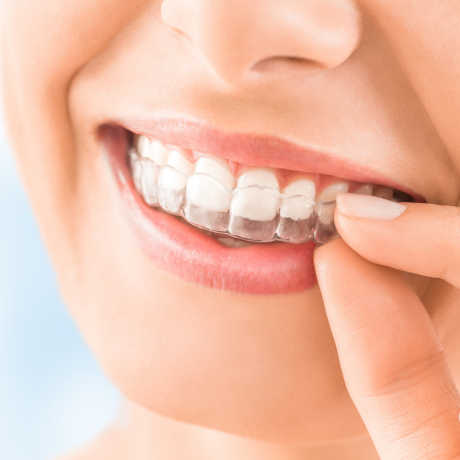Taking Care of Clear Aligners
Getting Started
Your first objective is to become accustomed to wearing your aligners. Many people want to wear their aligners full-time immediately, but others prefer to start wearing them gradually. The choice is purely personal. In any case, the goal is to have you wearing your aligners the entire day (except while eating and brushing) after the first week. In general, that would be about 22 hours per day.
General Soreness and Speech
Following each stage, people are usually sore for a day or two. That’s normal.
This is an indicator that the aligners are working and that your teeth are moving towards their final position. Your speech may temporarily be affected by aligners in rare cases. Within a week, any minor disruption in speech caused by the aligners will disappear as your tongue becomes accustomed to having the aligners in. In fact, most people have no problem with their speech at all.
Potential Aligner Harms from Eating
There is no restriction on the food that you may eat. Nevertheless, we recommend that your aligners be removed while eating and put in the carry case you received. A lot of aligners are lost while eating at restaurants. Treatment delays, extra office visits, and additional expenses are caused by lost and broken appliances. While wearing aligners, we recommend that you do not drink anything other than water to avoid caries, stains, and warping of the aligners from extremely hot drinks.
Aligner Insertion
- Be sure you have the correct aligner – the upper for top teeth and the lower for bottom teeth.
- In order to reduce confusion, each aligner is engraved with the stage number, U for upper and *L for lower.
- Insert either the upper or lower aligner first. The aligners should be pushed gently over the front teeth when being inserted. After that, apply equal pressure with your finger tips to your left and right molars (back teeth) until the aligner snaps into place. Be careful not to bite into your aligners. Biting them could damage them.
- Since the teeth need time to adapt to a new aligner’s position, minor discrepancies between the new aligner’s position and the teeth’s current positioning are normal. In any case, do not move to the next aligner if there is a problem with fit until you have been seen by our office.
Aligner Removal
- Start by removing aligners from one side, then work your way to the other side using aligner removal tools or your fingers.
- Avoid unnecessary removing of aligners.
- Do not use any sharp objects when removing your aligners.
- Your aligners should be rinsed with water immediately after using them, and any extra water should be shaken off before you store them.
- Keep the last aligners in their corresponding zip-lock bags as you move along.
Daily Care and Maintenance of Aligners
- Prior to each insertion of your aligners, make sure they are clean. Using water and toothpaste, brush your teeth thoroughly
- After cleaning your aligners, rinse them with water thoroughly
- Aligners should not be cleaned with denture cleaners or soaked in mouthwash. As a result, the aligner surface becomes dull and more visible.
At the time of changing your aligners, there should be no visible space between the edge of the teeth and the aligner itself. The aligners should always be tight enough over the teeth so that there is no space at the edge of the teeth. In the event of gaps in the aligner, aligner chewies should be used faithfully until the aligner fits properly.
Use the chewie by biting down and holding in the area where the aligner needs to fit better for 5 seconds, then release. Until the gap is reduced, repeat this process for 10 minutes at a time, three times a day.
Do not use chewies if you have a history of TMJ or jaw pain. Instead, use steady pressure to push the aligner into place, taking care not to press on your lower jaw if the problem is on the lower teeth.
Important points to remember
- It is recommended that aligners be worn for 22 hours per day. Aligners should only be removed when eating or brushing.
- When seating your aligners, massage the attachments from above and below.
- We recommend that you exercise for at least 20 minutes per day with your aligner chewies. By doing so, you’ll ensure that your teeth respond optimally.
- Be sure not to eat with your aligners in. When you eat or drink anything other than water, you should brush, floss, and insert your aligners as soon as possible.
- Placing aligners on dirty teeth causes cavities and gum disease.
- Whenever you are not wearing your aligners, store them in the storage case. Your aligners should not be placed in a pocket or napkin, as this may result in them being damaged or thrown away.
- Please keep your aligners away from pets. Cats and dogs often chew on used aligners.
- Attachments, or tooth-colored cement bumps, are applied to teeth to aid in tooth movement. There is no need to come back to the office if one of the bonded attachments falls off. Call us before your next scheduled appointment and we will replace it then.
- When inserting aligners start with your front teeth, and when removing aligners start with your back teeth.
- If you lose a set of aligners, replace it with the previous set or the next set in the series. Choose the set that suits your comfort level the most. Please notify us as soon as possible so that we can determine the best course of action.
- Please bring previously worn aligners to your appointment to backtrack if necessary.
- Make sure that your aligners are in your mouth when you come in for your appointment.
- Call the office if you can’t wear your aligners or they don’t fit (and go back to the last one that fit).
- Make sure you brush the inside of your aligners daily. They should be crystal clear all the time. Cloudy aligners are an indication that plaque has accumulated, which can cause extensive damage to your teeth, leading to scarring/decalcification, and cavities.
- Changing aligners at night before you go to bed minimizes any initial tightness or discomfort.
- If you lose or break an aligner: Move onto the next numbered aligner and stay in that aligner for longer. In case the next aligner does not fit, please return to the previous aligner and contact us immediately. You should contact us immediately if you don’t have your previous aligner for whatever reason.



